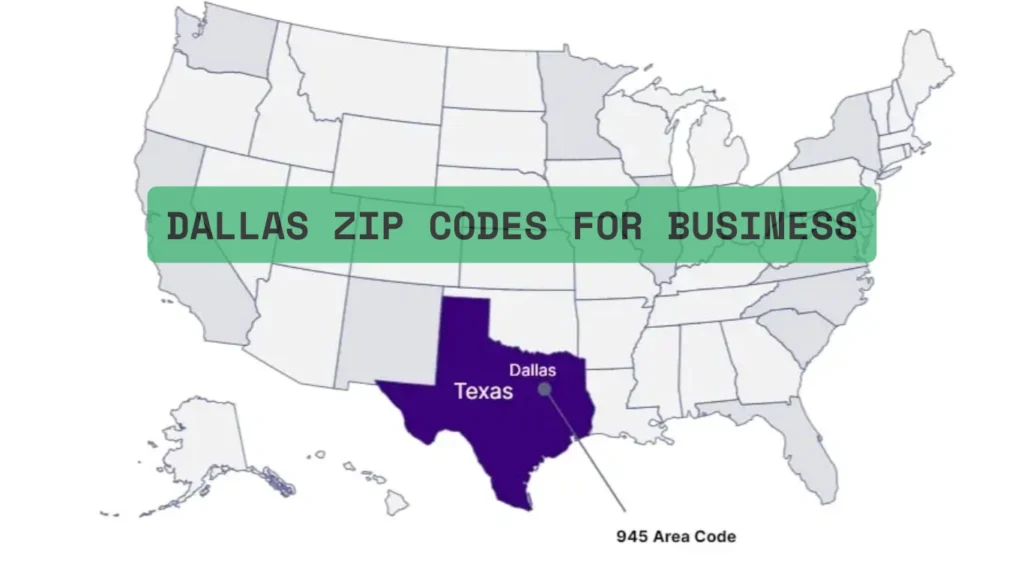Dallas Zip Code System: Find the Perfect Neighborhood for You
When it comes to living, working, or doing business in the Dallas metropolitan area, understanding the Dallas zip code layout can be incredibly helpful. Whether you’re searching for a new home, evaluating school districts, or targeting local marketing campaigns, zip codes tell a deeper story about each neighborhood. In this blog, we’ll walk through what makes the zip code system unique and how to use it to your advantage.
What Is a Zip Code and Why Does It Matter in Dallas?
A zip code is a postal code used by the United States Postal Service (USPS) to identify specific geographic delivery areas. In a city as large and spread out as Dallas, zip codes help break down the area into manageable regions for mail delivery, emergency services, urban planning, and even real estate analysis.
Dallas zip zones stretch across urban centers, historic neighborhoods, suburbs, and commercial districts. With over 90 zip codes in the Dallas area alone, each one reflects unique characteristics, demographics, and land use patterns.
Dallas Zip Code Map and Major Regions
Dallas is part of the Dallas-Fort Worth (DFW) metroplex, one of the largest metropolitan areas in the United States. The city’s zip codes start from 75201 (Downtown Dallas) and extend across multiple directions, including North Dallas, East Dallas, Oak Cliff, and Southern Dallas.
Here’s a simplified look at some prominent zip codes and the areas they cover:
| Zip Code | Neighborhood / Area | Description |
|---|---|---|
| 75201 | Downtown Dallas | Urban center, offices, luxury condos, high walkability |
| 75214 | Lakewood / White Rock Lake | Residential, near nature, family-friendly |
| 75219 | Oak Lawn / Uptown | Nightlife, LGBTQ+ friendly, young professionals |
| 75204 | Knox/Henderson / Old East | Trendy shops, dining, close to downtown |
| 75217 | Pleasant Grove | Affordable housing, large population |
| 75230 | North Dallas | High-income area, luxury homes, private schools |
| 75243 | Lake Highlands | Diverse, suburban, family-oriented |
Understanding the Dallas zip layout helps people choose where to live, invest, or open a business.
How Zip Codes Shape Real Estate Decisions in Dallas
One of the most practical uses of the zip code system is in the real estate industry. Buyers often filter their home searches by zip codes because each zone affects property values, taxes, school zones, and amenities.
For example:
- Zip code 75230 (North Dallas) includes prestigious neighborhoods like Preston Hollow and is known for upscale living.
- Zip code 75228 offers more affordable options with proximity to outdoor attractions like White Rock Lake.
Agents often use zip code maps to guide clients based on lifestyle, commute times, and budget.
Economic and Demographic Differences by Zip Code
Each zip code in Dallas carries a different socio-economic profile. You can find:
- Affluent communities with median home prices above $1 million
- Middle-income zones with diverse populations and growing retail
- Lower-income areas undergoing revitalization and gentrification
The zip code system reflects more than just delivery routes it maps out income levels, job hubs, housing styles, and population density.
For instance, in zip code 75219, you’ll find high-rise apartments, boutique shopping, and restaurants. Meanwhile, 75216 in Southern Dallas reflects different dynamics with larger family homes and a lower cost of living.
Using Dallas Zip Codes for Business and Marketing

For marketers, zip code data in Dallas provides powerful targeting potential. Many businesses run ads, direct mail, or promotions based on location data tied to zip codes.
If your company offers services like HVAC, pest control, or landscaping, targeting high-homeownership areas like 75229 (Bluffview area) can yield better returns. Tech companies or co-working spaces may find zip code 75201 or 75202 ideal for reaching professionals and startups in Downtown Dallas.
Zip Codes and Commute Times
Many residents also evaluate zip codes based on commute convenience. Zip codes closer to I-35, I-75, or I-635 often provide easier access to major business hubs.
For example:
- Zip code 75206 (Lower Greenville) provides a quick drive to Downtown
- Zip code 75287 (Far North Dallas) may require a longer commute but offers suburban peace
Knowing your zip code can help estimate drive times, access to public transportation, and nearby freeway access points.
How to Get a Dallas Zip Code Map
If you’re planning a move or launching a local campaign, having a detailed zip code map is essential. You can access printable or interactive zip code maps from:
- Dallas city websites
- USPS lookup tools
- Real estate platforms (like Zillow or Redfin)
- Local businesses offering map services
LoanPeople, for instance, provides detailed DFW zip code maps to assist homebuyers across Texas and other states. They serve clients in Texas, Oklahoma, Florida, Colorado, and more.
Conclusion:
Dallas is a big city with lots of different neighborhoods. Each zip code tells you something special about the area, like how people live, how much houses cost, and how far it is from work or school. If you’re moving, starting a business, or just want to learn more, zip codes can help you make smart choices. So next time you look at a map, remember zip codes are more than just numbers. They tell the story of Dallas!
FAQs:
Q: How many zip codes are in Dallas, TX?
A: Dallas has over 90 zip codes, each covering different neighborhoods and regions.
Q: What is the zip code for Downtown Dallas?
A: The primary zip code for Downtown Dallas is 75201.
Q: How do I find the best Dallas zip code to live in?
A: Consider your budget, school preferences, commute time, and neighborhood lifestyle.






